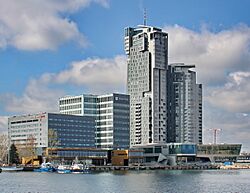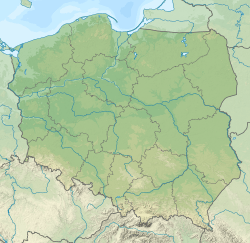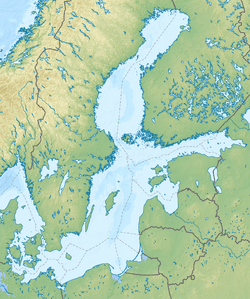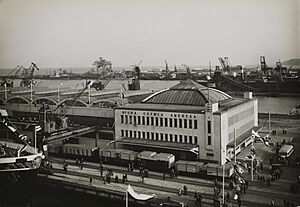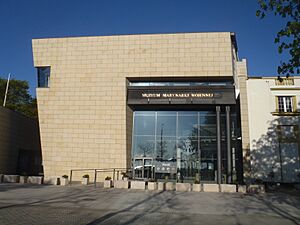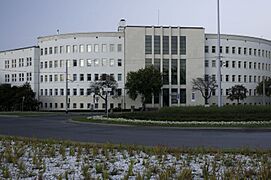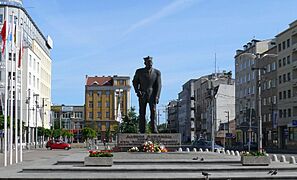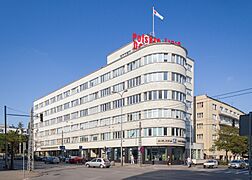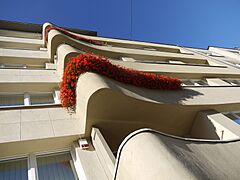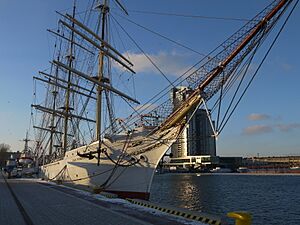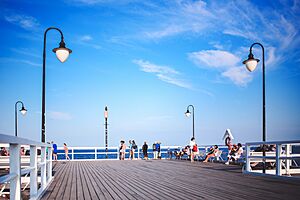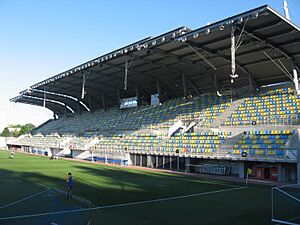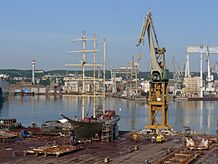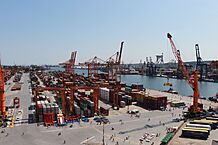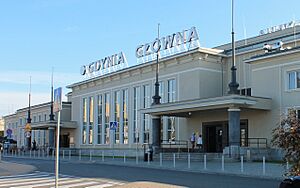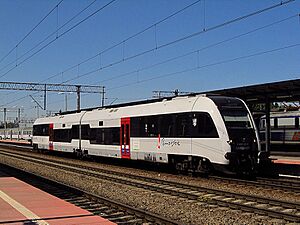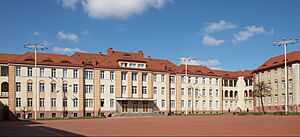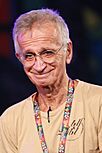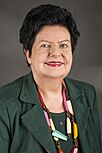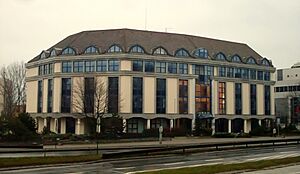Gdynia facts for kids
Quick facts for kids
Gdynia
Gdiniô (Kashubian)
|
|||||
|---|---|---|---|---|---|
|
|||||
|
|||||
| Motto(s):
Miasto z morza i marzeń
("The city of sea and dreams") |
|||||
| Country | Poland | ||||
| Voivodeship | Pomeranian Voivodeship | ||||
| County | city county | ||||
| City rights | 10 February 1926 | ||||
| Boroughs | 22 districts | ||||
| Area | |||||
| • City | 391.5 km2 (151.2 sq mi) | ||||
| • Land | 130.8 km2 (50.5 sq mi) | ||||
| Highest elevation | 205 m (673 ft) | ||||
| Lowest elevation | 0 m (0 ft) | ||||
| Population
(31 December 2021)
|
|||||
| • City | 257 000 |
||||
| • Density | 1,820/km2 (4,700/sq mi) | ||||
| • Metro | 1,080,700 | ||||
| Time zone | UTC+1 (CET) | ||||
| • Summer (DST) | UTC+2 (CEST) | ||||
| Postal code |
81-004 to 81-919
|
||||
| Area code(s) | +48 58 | ||||
| Car plates | GA, XA | ||||
| International airport | Gdańsk (GDN) | ||||
| Website | http://www.gdynia.pl | ||||
Gdynia is a city in northern Poland and an important seaport on the Baltic Sea coast. About 257,000 people live there, making it the 12th largest city in Poland. Gdynia is part of a bigger area called the Tricity (Trójmiasto). This area includes the cities of Gdańsk and Sopot, and has about one million people in total.
For many centuries, Gdynia was just a small fishing village. But in the early 1900s, it started to become a popular place for tourists. In 1926, Gdynia officially became a city. After that, it grew very quickly and became a major seaport for Poland. The city is known for its modernist buildings. Gdynia is also famous for hosting the yearly Gdynia Film Festival. In 2021, it was even named a UNESCO City of Film.
Contents
Exploring Gdynia's History
Early Beginnings
The area where Gdynia is located has a long history, connected to Pomerelia (Eastern Pomerania). The first known mention of "Gdynia" as a fishing village was in 1253. The first church on this part of the Baltic Sea coast was built here.
Over the centuries, Gdynia changed hands many times. It was part of Poland, then taken by the Teutonic Order, and later given to the Cistercian Order. In 1772, Gdynia became part of the Kingdom of Prussia. At that time, it was a very small village with only 21 houses in 1789. By the early 1900s, Gdynia was a popular tourist spot with guest houses and a small harbor. After World War I in 1918, Poland became independent again, and Gdynia rejoined Poland in 1920.
Building a Big Seaport
Poland decided to build a major seaport in Gdynia in 1920. This was important because Poland needed its own port that it fully controlled. The nearby city of Gdańsk was a "free city," and its workers sometimes went on strike, which caused problems for Poland's trade.
Construction of the Gdynia seaport began in 1921. It was slow at first due to money problems. But in 1922, the Polish parliament passed a law to speed things up. By 1923, a long pier and a small harbor were built. The first large ship arrived in August 1923.
Work on the port became even faster after 1926. This was because Poland's exports by sea increased, and a trade war with Germany made sea routes more important. By 1930, many docks, piers, and other important buildings were finished. The amount of goods shipped through Gdynia grew from 10,000 tons in 1924 to almost 3 million tons in 1929!
Between 1931 and 1939, Gdynia's harbor became even bigger. By 1938, Gdynia was the largest and most modern seaport on the Baltic Sea. It was also the tenth biggest in Europe. About 46% of all Polish foreign trade went through Gdynia.
How the City Grew

The city of Gdynia grew quickly after the seaport. In 1925, a special group was formed to plan the city's growth. Gdynia was granted city rights in 1926. The city really started to expand after 1928.
New buildings like a railway station and a post office were built. The railway lines were extended, and many houses were constructed for people moving to Gdynia. By 1939, the population had grown to over 120,000 people.
Gdynia During World War II
When World War II started in September 1939, Gdynia saw strong Polish defense. On September 14, 1939, German forces captured the city and occupied it until 1945. The Germans changed the city's name to Gotenhafen.
During the occupation, many Polish citizens were forced to leave Gdynia to make room for German settlers. Despite the difficult situation, local Poles formed resistance groups. They shared secret information, helped people escape, and worked against the German occupation.
The harbor became a German naval base. The shipyard was made bigger and became a branch of a German shipyard. Gdynia was an important base for German ships. The city and port were bombed by the Allies from 1943 onwards.
In the winter of 1944–45, Gdynia was used to evacuate German soldiers and refugees. Some of these ships were sunk by Soviet submarines. One ship, the Wilhelm Gustloff, sank with a huge loss of life, making it one of the worst maritime disasters in history. When German troops left in 1945, they destroyed much of the seaport.
After World War II
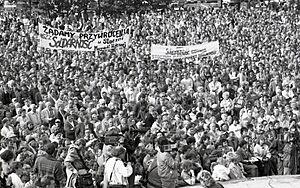
On March 28, 1945, the city was taken by Soviet forces and given back to Poland. Many people from other parts of Poland moved to Gdynia after the war.
On December 17, 1970, workers at the Gdynia Shipyard held protests. Police fired on the workers, and many were killed. This event was very important and helped lead to the Solidarity movement in nearby Gdańsk. One of Gdynia's streets is named after Janek Wiśniewski, one of the workers who died.
Gdynia's Geography and Climate
Weather in Gdynia
Gdynia has an oceanic climate because it is right on the Baltic Sea. This means the temperatures are not too extreme, and there is steady rain throughout the year. Autumns are usually warmer than springs because the sea keeps the air warm. Nights are also warmer than in places further inland. Like other places in Northern Europe, Gdynia doesn't get much sunshine in late autumn, winter, and early spring. But it gets a lot of sun in late spring and summer. In midsummer, Gdynia has about 17 hours of daylight, but only around 7 hours in midwinter.
| Climate data for Gdynia (1981-2010, extremes 1951–2015) | |||||||||||||
|---|---|---|---|---|---|---|---|---|---|---|---|---|---|
| Month | Jan | Feb | Mar | Apr | May | Jun | Jul | Aug | Sep | Oct | Nov | Dec | Year |
| Record high °C (°F) | 13.2 (55.8) |
14.4 (57.9) |
22.9 (73.2) |
28.9 (84.0) |
30.3 (86.5) |
33.2 (91.8) |
35.5 (95.9) |
33.4 (92.1) |
30.7 (87.3) |
26.9 (80.4) |
19.8 (67.6) |
13.7 (56.7) |
35.5 (95.9) |
| Mean maximum °C (°F) | 8.7 (47.7) |
8.4 (47.1) |
14.2 (57.6) |
19.4 (66.9) |
23.6 (74.5) |
26.2 (79.2) |
28.0 (82.4) |
27.8 (82.0) |
23.1 (73.6) |
19.3 (66.7) |
12.6 (54.7) |
9.4 (48.9) |
30.0 (86.0) |
| Mean daily maximum °C (°F) | 2.6 (36.7) |
2.9 (37.2) |
5.6 (42.1) |
9.8 (49.6) |
15.0 (59.0) |
18.4 (65.1) |
21.1 (70.0) |
21.2 (70.2) |
17.2 (63.0) |
12.5 (54.5) |
6.9 (44.4) |
3.6 (38.5) |
11.4 (52.5) |
| Daily mean °C (°F) | 0.5 (32.9) |
0.7 (33.3) |
2.9 (37.2) |
6.5 (43.7) |
11.6 (52.9) |
15.1 (59.2) |
18.0 (64.4) |
18.0 (64.4) |
14.2 (57.6) |
9.7 (49.5) |
4.8 (40.6) |
1.6 (34.9) |
8.6 (47.5) |
| Mean daily minimum °C (°F) | −1.6 (29.1) |
−1.4 (29.5) |
0.6 (33.1) |
3.8 (38.8) |
8.6 (47.5) |
12.3 (54.1) |
15.1 (59.2) |
15.1 (59.2) |
11.6 (52.9) |
7.3 (45.1) |
2.8 (37.0) |
−0.4 (31.3) |
6.1 (43.0) |
| Mean minimum °C (°F) | −9.6 (14.7) |
−8.1 (17.4) |
−4.5 (23.9) |
−0.7 (30.7) |
3.8 (38.8) |
8.0 (46.4) |
11.3 (52.3) |
10.9 (51.6) |
7.0 (44.6) |
1.4 (34.5) |
−3.1 (26.4) |
−7.7 (18.1) |
−12.0 (10.4) |
| Record low °C (°F) | −19.7 (−3.5) |
−23.8 (−10.8) |
−13.8 (7.2) |
−4.9 (23.2) |
−0.6 (30.9) |
3.8 (38.8) |
8.1 (46.6) |
7.0 (44.6) |
2.1 (35.8) |
−3.6 (25.5) |
−11.7 (10.9) |
−17.8 (0.0) |
−23.8 (−10.8) |
| Average precipitation mm (inches) | 31.5 (1.24) |
21.4 (0.84) |
30.6 (1.20) |
28.5 (1.12) |
53.3 (2.10) |
56.8 (2.24) |
60.8 (2.39) |
63.7 (2.51) |
62.8 (2.47) |
46.2 (1.82) |
43.9 (1.73) |
37.7 (1.48) |
537.0 (21.14) |
| Average precipitation days (≥ 0.1 mm) | 17.4 | 15.2 | 14.7 | 12.2 | 11.7 | 13.8 | 13.2 | 13.2 | 14.0 | 14.1 | 16.3 | 18.3 | 173.9 |
| Average relative humidity (%) | 81.7 | 81.5 | 79.5 | 77.7 | 77.0 | 76.5 | 77.1 | 77.7 | 79.1 | 80.7 | 83.4 | 83.6 | 79.6 |
| Average dew point °C (°F) | −3 (27) |
−3 (27) |
−1 (30) |
2 (36) |
6 (43) |
10 (50) |
13 (55) |
12 (54) |
9 (48) |
6 (43) |
2 (36) |
−1 (30) |
4 (40) |
| Source 1: Meteomodel.pl | |||||||||||||
| Source 2: Time and Date (dewpoints, 2005-2015) | |||||||||||||
City Districts
Gdynia is divided into smaller areas called dzielnicas and osiedles. Some of the main dzielnicas include: Babie Doły, Chwarzno-Wiczlino, Chylonia, Cisowa, Dąbrowa, Działki Leśne, Grabówek, Kamienna Góra, Karwiny, Leszczynki, Mały Kack, Obłuże, Oksywie, Orłowo, Pogórze, Pustki Cisowskie-Demptowo, Redłowo, Śródmieście, Wielki Kack, Witomino-Leśniczówka, Witomino-Radiostacja, and Wzgórze Św. Maksymiliana.
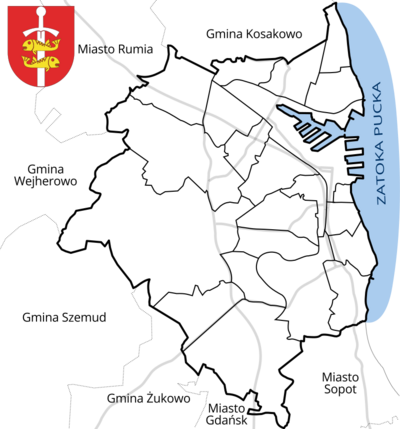
Doły
-Demptowo
Góra
Maksymiliana
-Radiostacja
Cityscape and Attractions
Gdynia is a modern city, but it also has some older buildings. The oldest building is the 13th-century St. Michael the Archangel's Church in Oksywie. There's also a 17th-century manor house in Orłowo.
The hills and coastline around Gdynia are beautiful and attract many nature lovers. You can visit a leisure pier and a cliff-like coastline in Kępa Redłowska. There's also a Nature Reserve nearby. In the harbor, you can see two amazing museum ships: the destroyer ORP Błyskawica and the tall ship Dar Pomorza. A 1.5 km (about 1 mile) long promenade goes from the city center to the beach in Redłowo.
You can get great views of Gdynia from Kamienna Góra (54 meters above sea level) or from a viewing point near Chwaszczyno. There are also two viewing towers, one at Góra Donas and another at Kolibki.
Gdynia has several interesting museums. The Emigration Museum opened in 2015. Other museums include the Gdynia Aquarium, Experyment Science Center, Gdynia Automotive Museum, Naval Museum, and Gdynia City Museum.
Modernist Architecture
Gdynia has many examples of early 20th-century architecture, especially modernism. The city center's design was planned in 1926. It focuses on connecting Gdynia and Poland with the Baltic Sea. You can see great examples of modernist buildings like the Bank of Poland and many apartment buildings called kamienice. The PLO Building on 10 Lutego Street is another good example.
Gdynia's modernist architecture is sometimes compared to the White City in Tel Aviv. The center of Gdynia has become a symbol of modern design. It is now listed as a historical monument of Poland and is being considered for the UNESCO World Heritage List.
Culture and Events
Gdynia is a lively city with many cultural events. It hosts the Gdynia Film Festival, which is the main Polish film festival.
Since 2003, Gdynia has been home to the Open'er Festival. This is one of the biggest contemporary music festivals in Europe. Many famous hip-hop, rock, and electronic music artists perform there every year. In 2018, over 140,000 people attended the festival.
Another fun summer event in Gdynia is the Viva Beach Party, a large two-day techno party on Gdynia's Public Beach. Gdynia also hosts events for the yearly Gdańsk Shakespeare Festival. In 2014, Gdynia even hosted the Red Bull Air Race World Championship.
Sports in Gdynia
Gdynia is home to many sports teams:
- Arka Gdynia – a men's football team that has won the Polish Cup twice.
- Bałtyk Gdynia – another men's football team.
- Arka Gdynia (basketball) – a men's basketball team that has won the Polish Basketball League nine times.
- Arka Gdynia (women's basketball) – a women's basketball team that has won the Basket Liga Kobiet twelve times.
- RC Arka Gdynia – a rugby team that has won the Polish Championship four times.
- Seahawks Gdynia – an American football team that has won the Polish Championship four times.
- Arka Gdynia (handball) – a handball team that plays in the top Polish league.
Major Sports Events
Gdynia has hosted several big international sports events:
- 2017 UEFA European Under-21 Championship
- 2019 FIFA U-20 World Cup
- 2020 World Athletics Half Marathon Championships
Economy and Transportation
Port of Gdynia
The Port of Gdynia is very busy. In 2007, it handled over 364,000 passengers and 17 million tons of cargo. There is a regular car ferry service that travels between Gdynia and Karlskrona, Sweden.
Public Transport
Gdynia has one of only three trolleybus systems in Poland. There are 18 trolleybus lines, covering a total length of 96 km (about 60 miles). The trolleybuses are modern. There is also a special historic line with retro trolleybuses. Gdynia also has a large network of bus lines that connect the city with its nearby areas.
Airports
The main airport for the Tricity area is Gdańsk Lech Wałęsa Airport. It is about 25 km (15 miles) southwest of central Gdynia and has flights to about 55 places. It is the third largest airport in Poland.
There is also a local airport, Gdynia-Kosakowo Airport, located partly in Gdynia. It used to be a military airport. There were plans to use it for civilian flights, but this project faced problems and was stopped.
Road and Rail Travel
Trasa Kwiatkowskiego connects the Port of Gdynia and the city to the main highway, A1 motorway. National road 6 connects the Tricity area with other cities like Słupsk and Szczecin.
Gdynia Główna railway station is the main train station in Gdynia. It is the busiest station in northern Poland. Local train services are provided by the 'Fast Urban Railway,' Szybka Kolej Miejska (Tricity). This system runs frequent trains connecting Gdynia with Gdańsk and Sopot. You can also take long-distance trains from Gdynia to major cities like Warsaw, Kraków, and Szczecin. In 2014, new high-speed trains started running between Gdynia, Warsaw, and Kraków, making travel times much shorter.
Local Economy
Many important companies have their main offices or regional branches in Gdynia. These include:
- PROKOM SA – a large Polish I.T. company.
- C. Hartwig Gdynia SA – a major Polish company that handles shipping goods.
- Sony Pictures – has a finance center here.
- Thomson Reuters – a company that provides business information.
- Vistal – builds bridges and works in the offshore and shipbuilding industries.
- Nauta – a ship repair yard.
- Crist – builds ships and offshore structures.
Education Opportunities
Gdynia has 8 universities and higher education institutions. Many students from Gdynia also go to universities in the wider Tricity area.
Some of the universities in Gdynia are:
- Gdynia Maritime University
- Polish Naval Academy
- WSB Merito Universities – WSB Merito University in Gdańsk, with departments in Gdynia.
- Academy of International Economic and Political Relations
- University of Business and Administration in Gdynia
- Pomeranian Higher School of Humanities
- Cardinal Stefan Wyszyński University – has a department in Gdynia.
- Higher School of Social Communication
Famous People from Gdynia
Many interesting people have come from Gdynia or have lived there. Here are a few:
- Jacek Fedorowicz (born 1937) – a famous satirist and actor.
- Tova Friedman (born 1938) – a therapist, author, and Holocaust survivor.
- Jan Kaczkowski (1977–2016) – a Roman Catholic priest and vlogger known for his work with hospices.
- Tomasz Makowiecki (born 1983) – a musician, singer, and songwriter.
- Anna Przybylska (1978–2014) – a popular actress and model.
- Joanna Senyszyn (born 1949) – a politician and former Member of the European Parliament.
- Wojciech Szczurek (born 1963) – the Mayor of Gdynia since 1998.
- Józef Unrug (1884–1973) – a German-born Polish vice admiral who helped create the Polish navy.
Athletes from Gdynia
Gdynia has also produced many talented athletes:
- Monika Pyrek (born 1980) – a retired pole vaulter who competed in several Olympic Games.
- Anna Rogowska (born 1981) – another pole vaulter who won a bronze medal at the 2004 Summer Olympics.
- Michael Klim (born 1977) – a Polish-born Australian swimmer who won an Olympic gold medal.
- Klaudia Jans-Ignacik (born 1984) – a retired tennis player who competed in the Olympics.
- Olek Czyż (born 1990) – a professional basketball player who played for Poland.
International Connections
Consulates in Gdynia
Gdynia hosts 10 honorary consulates. These are offices that represent other countries and help their citizens. The countries with consulates in Gdynia are: Belgium, Chile, Cyprus, Denmark, Finland, France, Italy, Luxembourg, Malta, and Norway.
Sister Cities
Gdynia is twinned with several cities around the world. This means they have special friendly relationships and often work together on projects.
 Aalborg, Denmark
Aalborg, Denmark Baranavichy, Belarus
Baranavichy, Belarus Brooklyn (New York), United States
Brooklyn (New York), United States Busan, South Korea
Busan, South Korea Côte d'Opale (communauté), France
Côte d'Opale (communauté), France Haikou, China
Haikou, China Karlskrona, Sweden
Karlskrona, Sweden Kiel, Germany
Kiel, Germany Klaipėda, Lithuania
Klaipėda, Lithuania Kotka, Finland
Kotka, Finland Kristiansand, Norway
Kristiansand, Norway Kunda (Viru-Nigula), Estonia
Kunda (Viru-Nigula), Estonia Liepāja, Latvia
Liepāja, Latvia Plymouth, England, United Kingdom
Plymouth, England, United Kingdom Seattle, United States
Seattle, United States
Gdynia used to be twinned with Kaliningrad, Russia, but this partnership ended in 2022.
Images for kids
See also
 In Spanish: Gdynia para niños
In Spanish: Gdynia para niños


